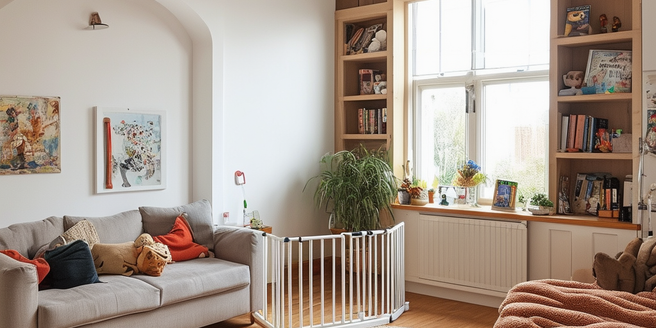
Identifying Common Household Hazards
When baby-proofing your home, it’s crucial to recognize common household hazards. Electrical outlets should be covered to prevent curious little fingers from getting shocked. Be sure to inspect each room from your baby’s perspective to identify potential dangers. Ensure that small objects, such as coins and buttons, are kept out of reach to avoid choking risks. Look out for sharp corners on furniture and install corner guards to prevent injuries. Additionally, keep cleaning supplies and medications in locked cabinets, as these can be highly dangerous if ingested. Strangulation hazards, like cords from blinds, should be secured out of toddlers’ reach. By addressing these areas, you can create a safer environment for your baby.
Essential Baby-proofing Tools and Supplies
To properly baby-proof your home, you will need a variety of tools and supplies. Outlet covers and cabinet locks are essential for keeping children away from dangerous areas. Baby gates can prevent access to stairways and hazardous rooms. Additionally, remember to install window guards to prevent accidental falls from any height. Furniture straps and wall anchors are necessary for securing heavy furniture and TVs to prevent tipping accidents, which can be very serious. Corner and edge guards help protect against falls that can cause injuries. Door knob covers and stove knob covers can prevent babies from gaining access to potentially dangerous areas and appliances. Investing in these essential tools will greatly enhance the safety of your home.
Securing Furniture and Heavy Appliances
Securing furniture and heavy appliances is a critical aspect of baby-proofing. Unsecured dressers, bookshelves, and televisions can tip over if a child tries to climb them, posing serious risks. Use furniture straps and anchors to firmly attach these items to the wall. It is also advisable to move any climbable furniture away from windows to prevent falls. In addition, consider placing edge and corner protectors on sharp furniture edges. Check that all screws and bolts are tightened properly, and inspect secured furniture regularly. Heavy appliances like stoves and refrigerators should also be anchored to prevent tipping. Never place tempting items, such as toys, on top of unsecured furniture, as this could encourage your child to climb. Properly securing these items will help prevent potentially deadly accidents.
Baby-proofing the Kitchen and Bathroom
The kitchen and bathroom are often the most hazardous rooms in the house for young children. Install safety latches on cabinets and drawers to keep babies from accessing dangerous items like knives, cleaning supplies, and medications. It’s also a good idea to store these hazardous items high and out of reach when possible. Use stove knob covers to prevent accidental burns from curious hands. Make sure all electrical outlets are covered to avoid electric shocks. Keep hot items away from the edge of counters and tables where children can reach them. In the bathroom, always keep toilet lids closed and consider using a toilet lock. Ensure that bathtubs and sinks are never left filled with water, and always supervise your child during bath time to prevent drowning risks.
Creating Safe Outdoor Spaces
Creating safe outdoor spaces is just as important as indoor baby-proofing. Start by ensuring that your yard is securely fenced, with no gaps that a child could squeeze through. Remove any hazardous plants and chemicals that could be within reach of little hands. It’s also a good idea to regularly inspect the area for any new dangers that may arise over time. Check that outdoor play equipment is sturdy and in good condition, with no sharp edges or potential fall hazards. Pool areas should be entirely fenced with a self-latching gate to prevent accidental drowning. Supervise your child at all times when outdoors, and create a designated safe play area with soft ground coverings like mulch or grass.
